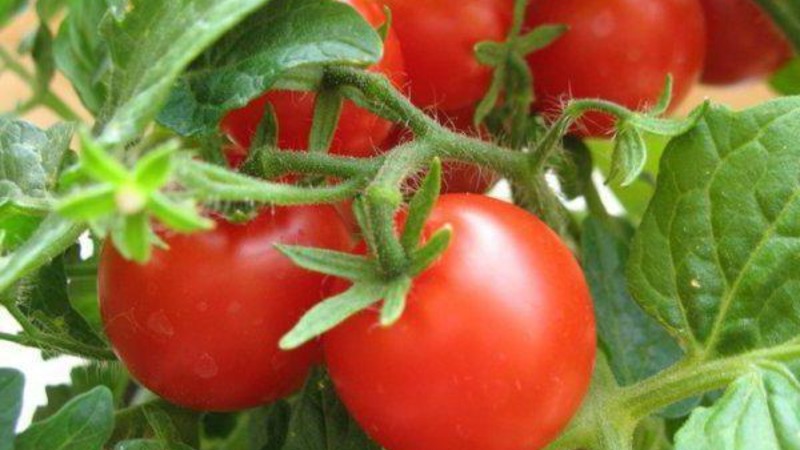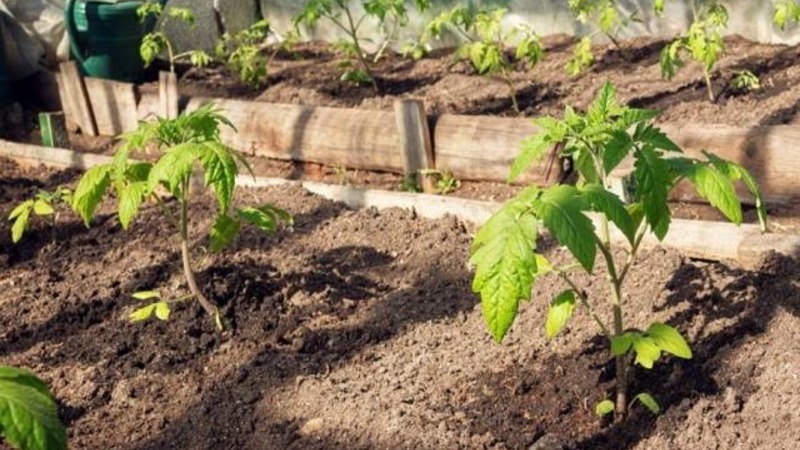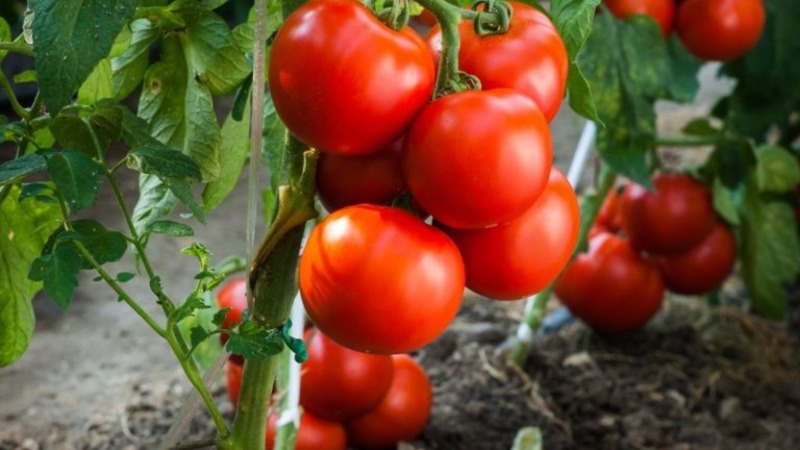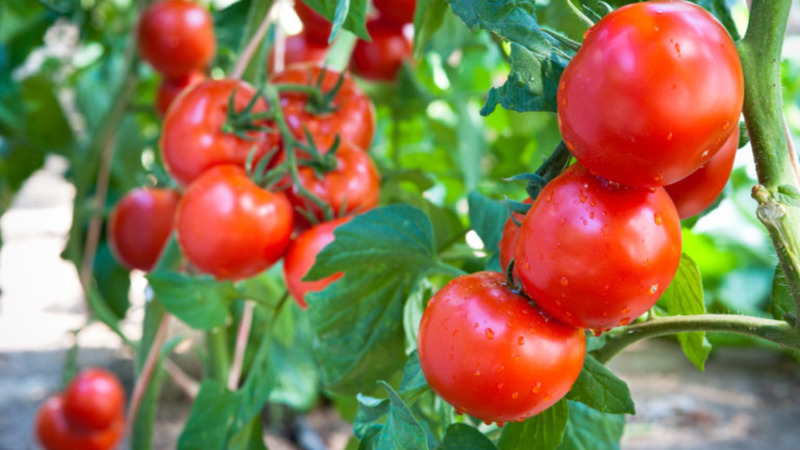Bright and tasty Dutch tomato variety "Tanya": we get acquainted with the advantages and grow ourselves
The homeland of the Tanya variety is Holland, but this is not an obstacle for most Russian vegetable growers, who are happy to grow a hybrid on their plots. The species has established itself as a high-yielding (despite its small growth), resistant to many diseases and unpretentious in care.
The culture is ready to please gardeners with the excellent taste of vegetables, provided that they are regularly watered and fed. Many of those who have planted a hybrid in their beds at least once do not want to part with it and are looking forward to next season to take care of their beloved guest from distant Holland again.
The content of the article
Description of the variety
Bred in Holland by Seminis Vegetable Seeds. Recommended for open field cultivation, although it grows well in closed structures... The Russian tomato variety Tatiana is very similar to its Dutch namesake, it is practically its analogue.

Mid-season hybrid, from the moment of emergence to full maturation, 110 - 120 days pass.
Determinant bush, standard, undersized, compact... Height up to 65 cm. Leaves are large, dark green. The inflorescences are simple, the first inflorescence is laid over 6-7 leaves, the subsequent ones - every 1-2 leaves.
Reference! Standard tomatoes, having reached a certain height and having thrown out 5-6 brushes, end up and stop growing.
The yield is high, up to 5 kg of fruits are harvested from 1 bush, subject to planting 4-5 seedlings per 1 sq. m.
Resistant to diseases of the nightshade family such as: late blight, gray spot, alternaria, verticillary wilting.
The hybrid does not require pickling, but the garter of low-growing bushes is required, since the branches, densely covered with fruits, do not support their weight.
Fruits are medium in size, weighing 150-170 g, round shape, bright red color, firm skin... The taste is sweet, rich in vitamins, especially vitamin C.
Versatile in application, suitable for fresh consumption, for winter harvesting and for the preparation of tomato products... They preserve their taste perfectly in pickles and marinades.
Ripe vegetables are subject to long-term storage and can withstand long-distance transportation without loss of appearance and taste.

The photo shows the tomato Tanya f1.
Read about other varieties of tomatoes:
Tomato "Japanese brush" and its benefits
Tomato Em Champion: characteristics and description of the variety
Tomato "Japanese crab", which will not leave anyone indifferent
How to grow seedlings
Sowing seeds begins 2 months before planting seedlings in the ground... Pre-prepare the soil, consisting of an equal amount of sod land and humus. The prepared soil must be disinfected with boiling water or by roasting in the oven for 10 minutes. After cultivation, the land is poured into planting containers. You can plant it in common wooden boxes, and in individual containers: plastic glasses or peat pots.
Reference! Planting in a wooden box is the cheapest way to grow seedlings, and the most expensive is peat pots.
Before sowing, seeds, like the soil, are treated with disinfecting solutionsand. The simplest and most affordable option is saline. 1 g of salt is diluted in 100 ml of water and grains are placed in it for 1 day.
Reference! Grains sown in peat pots show the highest germination capacity.
Seeds are laid to a depth of 1 cm, the distance between them is 2 cm... Then they are covered with a small amount of soil and moistened with warm, settled water using a spray bottle. The containers are covered with foil and left in a dark and warm room at a temperature of 25 degrees.
After 3-4 days, the first shoots appear, after which the film is removed and the containers are rearranged in a lighted place... Daylight hours for seedlings should be at least 12 hours. If necessary, additional lighting is illuminated with phytolamps.
Water the seedlings as the top layer of the soil dries up... For watering, use warm, settled water, which moisten the edges of the nursery with tablespoons or a shallow watering can.
A pick is carried out when 2-3 true leaves appear... If the seedlings were planted in a common box, then during the pick they are seated in separate containers.
2 weeks before transplanting into the ground, the seedlings begin to harden... To do this, the planting containers are taken out into the street and left for 2-3 hours, gradually increasing this interval to 16 hours. In parallel with daytime hardening, the temperature in the room where the seedlings are located at night is reduced to 13 degrees.

How to grow tomatoes
After 60 days, the seedlings are ready for transplanting to the beds.... At this time, the height of the bushes is 20 cm, they have 5-7 true leaves and developed roots. The soil under the tomatoes is dug up and fertilized with compost or humus. Also, mineral fertilizers are applied in the amount of 20 g per 1 sq. m.
Landing scheme: 50 cm is the distance between seedlings, 60-65 cm is left between the rows.
Saplings are planted in a hole 20 cm deep, compact the soil and water abundantlyt. It is best to replant tomatoes in the evening or in cloudy weather.
Regular watering is established 10 days after transplanting... By this time, young bushes finally adapt to new conditions and grow. Watered sparingly, at the root, without falling on the leaves. The variety reacts sharply to both an excess of moisture and a lack of it.
With aridity, the leaves curl and the ovaries fall off, and waterlogging leads to a slowdown in growth and the spread of fungal diseases... Watered 1-2 times a week, in the morning or in the evening, with warm settled water.
After watering, the earth is loosened, spud and mulched... Loosening improves oxygen access to the roots, due to which the seedlings absorb nutrients well. Mulching the beds with straw or peat retains moisture in the beds, so the amount of watering can be reduced. In any case, you need to focus on weather conditions and soil moisture level.
The first top dressing is applied 2 weeks after transplanting... Phosphorus and potassium based dressings are used. As a rule, these are superphosphate and potassium sulfate. Phosphorus stimulates the development of plants and improves their immunity, while potassium improves the palatability of fruits. Such dressings are carried out once every 10 days. During flowering, the hybrid is sprayed with a solution of boric acid, at a dilution of 5 g per 5 liters.
The culture of pinching does not require, which greatly simplifies care, but it needs a mandatory garter... The shrub is undersized, but spreading, each fruitful cluster forms 4-5 fruits, and without a garter the branches cannot support the weight of ripe vegetables. As a support, trellises are installed next to each seedling and a wire is pulled between them to which the branches of the tomato are tied. Thus, the stem grows straight and strong, and the fruits do not reach the ground.
More about tomatoes:
Review of the Ogorodnik tomato: advantages and disadvantages
A good choice even for novice gardeners is the Mashenka tomato
Diseases and pests
Tomato Tanya F1 is immune to the main diseases of the Solanaceae family, but there are times when there is a risk of infection from other cropsgrowing in the neighborhood. Therefore, any preventive measures will not be superfluous, no matter how strong the culture may have immunity.
Copper sulfate is used as a preventive measure... It disinfects plants and soil, which prevents the spread of fungal diseases, such as late blight. Control the level of humidity in the beds, water and loosen the soil in a timely manner, and regularly inspect the plantings for the presence of insects.
From folk remedies for the invasion of insects, spraying plants with decoctions of herbs - calendula, burdock, onion arrows... Sometimes a little potassium permanganate is added to such decoctions. Sharp-smelling plants planted next to tomatoes are also a preventive measure.
Attention! Hanging pheromone traps save from parasitic butterflies without harming other insects that are not pests.
The nuances of growing in open ground and in a greenhouse
The hybrid is recommended for breeding throughout the country.... In southern regions and in regions with a temperate climate, the tomato is planted in open ground. In areas where it is cold for a long time, the culture can take root only in greenhouses.

Tomato beds are chosen in a sunny place, protected from drafts.... If the summer is cool, you need to have a covering material on hand. Otherwise, the prolonged influence of negative weather factors will lead to a decrease in yield.
Since the branches of the tomato are spreading, in protected structures, the distance between the seedlings when planting is advised to leave more, to avoid thickening... Greenhouse plants are most likely to be affected by mold due to high humidity and air temperature. Therefore, the greenhouse must be regularly ventilated to avoid fungal diseases.
Spider mite is another scourge of the greenhouse... To protect against it, ventilate the greenhouse regularly.
Harvesting and application of the crop
Harvesting begins 2 months after planting seedlings in the ground... Fruiting is long, ripening is gradual, not amicable.
It is not necessary to wait for the vegetables to fully ripen... Unripe fruits will ripen on their own in a few days.
At a temperature of 12 degrees, the fruits are removed green, they will not be able to gain color on the beds, but quite capable of getting sick or rotting.
The purpose of the fruits is universal, they are used to prepare a huge number of dishes... Fresh they are used in salads, hot dishes, in baking. Do not lose their taste in pickles, marinades, small tomatoes are suitable for whole-fruit canning. The dense skin of a tomato is perfectly preserved during heat treatment. Also, juices, pasta and ketchup are made from tomato.
Ripe vegetables are subject to long-term storage and can withstand transportation to any pointwithout losing taste and presentation.

Advantages and disadvantages
The review will summarize the positive characteristics of the species and note some negative aspects. Here are the merits of a hybrid:
- high rate of fruiting;
- unpretentious care;
- the ability to take root in any region;
- immune to disease;
- does not require pinning;
- great fruit taste;
- marketable condition;
- long-term storage;
- long-distance transportation;
- versatility in cooking.
Negative sides:
- requires a mandatory garter;
- poor tolerance of insufficient or excessive watering.
Farmers reviews
Farmers characterize the crop as requiring the minimum investment of time and effort, but at the same time with the maximum quantitative indicator... In addition, vegetables with excellent taste suit everyone with their universal purpose. Here are the opinions of some gardeners:
Matvey, Cherepovets: “I've been planting a hybrid for several years now. Perfect for winter harvesting - the fruits are small and strong. A big plus is that they can be stored for several months. I use them for pickles and making tomato paste ".

Stanislav, Perm: “I plant it in open ground. I pick vegetables green. This unloads the bush to stimulate fruiting. Tomatoes lie for a long time, even when ripe.They go well in salads and home canning ".
Conclusion
Dutch tomato Tanya attracted many Russian vegetable growers for its endurance and adaptability to any climate, immunity to most dangerous diseases, ease of care and excellent fruiting rate. The variety of uses in cooking makes the variety even more popular, and the number of gardeners who want to see a hybrid in their beds is increasing every year.